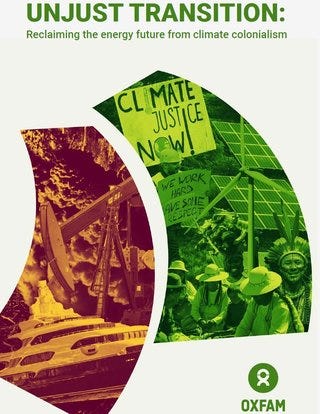An unjust transition
Who will benefit and who will bear the costs from the renewable energy transition?
The renewable energy revolution seems like it could only be a good thing, right? The world is on the brink of blasting through the globally agreed 1.5°C goal. At a time when many governments are turning their backs on the planet, record levels of investment in solar, wind and other renewable energy sources seem like a good news story during bleak times.
However, few ask, who is benefiting and who is bearing the costs of the energy transition? Fortunately, Oxfam’s latest report, ‘Unjust Transition: Reclaiming the energy future from climate colonialism’, sets out a vivid warning of an extractive transition and how mistakes of the colonial past can be avoided.
Climate colonialism in numbers
Oxfam’s calculations and sources for many of these stats can be found in the methodology note and report here.
Energy inequality. Around 666 million people still live without even basic access to electricity, and 2.1 billion lack access to clean cooking fuels. Energy poverty is highly concentrated and unequal. Sub-Saharan Africa accounts for 85% of the global population without electricity, and in the last decade, the richest 10% of people have consumed half of all global energy, while the poorest 50% have shared just 8%.
Nowhere is energy inequality more visible than in the lives of women and girls, who bear the brunt of energy poverty. Women in rural South Asian communities collectively spend an estimated 507 million hours each day collecting fuel.
Southern extraction, same story, different minerals. The Global South holds 70% of the world’s transition minerals reserves, but much of the value is taken by foreign investors. Latin America, for example, has over 50% of the world’s lithium reserves, an essential mineral for battery technologies, yet more than 90% of the value is captured outside the region, largely by companies in China, Europe and the United States.
As the economic powerhouses of the Global North race to decarbonise, the Global South will, again, be increasingly relied upon for resource extraction.
Land that should not be up for grabs. Renewable energy projects and transition mineral mining require vast territories, intensifying demand for land. 60% of Indigenous lands covering around 22.7 million km², an area roughly the size of Brazil, the USA and India combined, are currently under threat or face imminent threat from industrial development linked largely to the energy transition.
This is alarming given Indigenous Peoples’ vital role in safeguarding the planet – they manage 40% of all protected land for conservation.
An economy of extraction. In 2024, high-income countries accounted for roughly 50% of global clean energy investment and China for 29%, while Latin America received 3%, and South-East Asia, the Middle East and Africa received just 2% each.
Energy projects in the Global South often benefit foreign investors, hidden in a web of complicated corporate structures. Although Brazilian entities officially own 89% of wind parks, 68% of these organisations are subsidiaries of international companies – mainly from Italy and France – giving foreign investors substantial control, with international stakeholders holding 78% of wind assets and 96% of solar assets.
Rising debt. While rich countries can pour billions into their own clean energy transitions, the Global South is left with rising debt, punishing interest rates and shrinking fiscal space. Current models of climate financing exacerbate the problem, with 70% of international public climate finance reported by high-income countries delivered as loans rather than grants.
The countries that are among the most vulnerable to the impacts of climate change are being pushed deeper into debt to respond to a crisis they did not cause. In reality, it’s high-income countries that should be in the red, to the tune of up to $192 trillion, for their overuse of the carbon budget.
Clean energy, dirty prices. Global South countries face interest rates of 9–13.5% for clean energy projects, compared to 3–6% in the Global North. Clean energy for 100,000 people costs $95m in advanced economies, but in countries such as India, it costs around $139m (45% higher), in Nigeria, it costs around $188m (97% higher), due to higher financing costs and perceived risks imposed by the Global North.
Reclaiming the future. It does not have to be this way. The energy transition offers a rare chance to rewrite the script – to move beyond extractive models. Rather than treating the energy future as a race with few winners, we must reimagine it as a shared global project. Energy should not be hoarded, withheld, or used as leverage for geopolitical or corporate power.
There is no single blueprint for a just transition – it will differ across contexts, shaped by diverse histories, knowledge and needs. But all just transitions must share one principle: energy should serve life, not profit.
Something to read and listen to
Listen to the latest Equals episode, hear from three trade union leaders - from Ukraine, South Korea and the UK - about how working people are standing strong against war, exploitation, and political repression
Read Adam Tooze’s latest on MAGA & the moment of hyperscaling.
Read about the ‘Zucman tax’ (or should it be the Bernard Arnault tax?), which is dominating political debate in France at the moment. Huge public support is certainly causing consternation amongst the billionaire class who are organising to counter Zucman’s ‘théories dangereuses’!




